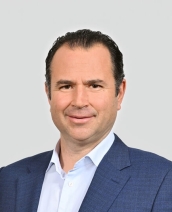Samih Coskun Baban
Managing Partner
Executive committee
Head of Arthur D. Little for Americas and Eastern Europe, Head of Arthur D. Little Turkey
Coşkun advises leading telecommunication, media and industrial conglomerates on corporate strategy, business planning and performance optimization.

Areas of Focus
Education
Past Experience

Coşkun is Managing Partner, Member of the Executive Committee and Head of Arthur D. Little for Americas and Eastern Europe. He also leads Arthur D. Little’s Istanbul Office. He has 20 years of consulting experience, focusing on corporate strategy development, business planning and turnaround projects with leading automotive, telecommunication, media and finance players in Greece, Spain, Turkey and the Middle East.
Since joining Arthur D. Little in 2016, Coskun has supported leading conglomerates across multiple strategic fronts, such as growth-strategy formulation, efficiency enhancement, regulatory strategies & market analysis and commercial excellence.
Before joining Arthur D. Little, he had co-established and was responsible for leading Value Partners Management Consulting’s Istanbul Office. He began his career as business analyst at Accenture, where he spent about 10 years and left the firm as Senior Engagement Manager.
Besides his consulting career, Coskun is passionate about demanding sports such as water polo, sailing, skiing and scuba diving.

Pricing for crisis

After the hype: Where is the carbon car?

What’s next for aerospace composites?

Multi-brand airline groups: A winning approach?

Coşkun is Managing Partner, Member of the Executive Committee and Head of Arthur D. Little for Americas and Eastern Europe. He also leads Arthur D. Little’s Istanbul Office. He has 20 years of consulting experience, focusing on corporate strategy development, business planning and turnaround projects with leading automotive, telecommunication, media and finance players in Greece, Spain, Turkey and the Middle East.
Since joining Arthur D. Little in 2016, Coskun has supported leading conglomerates across multiple strategic fronts, such as growth-strategy formulation, efficiency enhancement, regulatory strategies & market analysis and commercial excellence.
Before joining Arthur D. Little, he had co-established and was responsible for leading Value Partners Management Consulting’s Istanbul Office. He began his career as business analyst at Accenture, where he spent about 10 years and left the firm as Senior Engagement Manager.
Besides his consulting career, Coskun is passionate about demanding sports such as water polo, sailing, skiing and scuba diving.

Pricing for crisis

After the hype: Where is the carbon car?

What’s next for aerospace composites?

Multi-brand airline groups: A winning approach?
More About Samih Coskun
- Bogazici University, IstanbulBSc, Electrical & Electronics Engineering
- Value Partners Management ConsultingPartner
- AccentureSenior Engagement Manager
